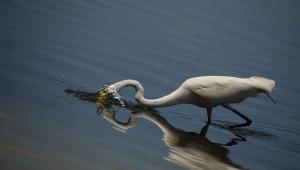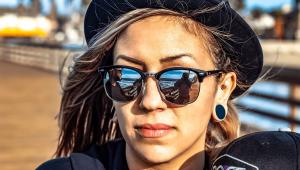Photogenic Digilight Tungsten Light Units
When a photographer hears the name "Photogenic Machine Company," he or she immediately thinks of small rugged AC-powered flash units used primarily by portrait photographers. Photogenic Powerlights have been around for decades, and have established an enviable record of durability. While the newer monolights like the sophisticated Powerlight 2500DR offer all of the modern bells and whistles, Photogenic has largely stood for simplicity. A few years ago when digital imaging started to bully its way into the pro photography domain, one of the hot new technologies was the scan back. I've written about backs from Dicomed, Better Light, Phase One, and Kigamo in past issues, and if you recall, a scan back needs a lot of continuous lighting. (Since it actually scans the "film plane" of a 4x5 camera and produces a big, sharp detailed image.) That means put your flash packs and heads away and break out the hot lights. A Flash World |
|||
One of the problems with the Starlite and most other existing hot lights is that they are purpose built. The Starlite is designed for use with softboxes, and most movie lights like Arri, Colortran, and Lowel Light weren't really designed to work with softboxes. What to do if you're a working pro who needs light heads that can work both with reflectors and softboxes? Years ago I found some old Balcar tungsten heads that would do the trick, but they were relatively light duty and over the years I've had to have them modified with heavy-duty lamp sockets and cooling fans. Today if you'd like to outfit your studio with such a beast you've finally got a brand-new, well-engineered solution--the new Photogenic Digilights. The Digital Party Rugged Build While the Digilights are called "1200" and boast a maximum capacity of 1200w, they ship with a standard FEL lamp, which is 1000w. Since I already own quite a few FEL equipped cine lights I knew that when I inevitably burned out a lamp I could replace it with a widely available bulb. |
|||
Safety First Comparing the output of the Digilight 1200 with a 1000w Colortran cine light, the Colortran is about 2/3 of a stop brighter. However, the quality of the light with the glass cover in place becomes extremely nice. The units that I had a chance to use came with the classic Photogenic 14" spun aluminum reflectors. These are the units favored by old-fashioned portrait guys for their combination of reasonable softness and good "snap" when shooting to color negative film. To get a similar lighting effect required me to put a sheet of Rosco Tufflux diffusion material in front of the Colortran reflector. Now the meter showed the Photogenic in the lead by 1/3 of a stop. Two Options At Work |
|||
First, I shot the watch itself. For this I put the two Photogenic units in Chimera softboxes and angled a white reflector up from the bottom of the watch. This gave me excellent softness but just enough specularity to reveal the pattern of the stainless steel. The Photogenic units worked exceptionally well for close-up work, since their cooling fans kept the units from overheating when covered by the Chimera banks. I got a nice f/22 exposure with a 2:15 sec scan. Color balance was spot on 3200Kelvin, so I was able to use my existing white balance settings. Next, I exposed for the diamonds. For this I used my custom-made circle of Plexiglas into which I set the watch, which was hot glued to a wire armature. I used two Photogenic 1200 heads with reflectors and two small Lowel Omni hot lights to perfectly illuminate the plexi ring. The resulting image was a perfect diamond shot, though now the watch face lacked "pop." The last shot was the strap, which on the Teno watches is a textured strip of black rubber. I tried just about every combination of softboxes, reflector cards, and mini spotlights. No luck. In almost every case I wound up with lighting that was either too harsh or too flat. Finally, I tried the Photogenics with the big aluminum reflectors. That seemed like just the right compromise. I was able to get a nice amount of texture on the strap and just enough softness to avoid looking like a spotlight. I got a nice fast scan and got to work assembling the ad. Evaluation |
|||
I shot a few pictures with both my Canon D30 and my Canon G1 and found the Photogenic lights produced perfect neutral results when set to "tungsten." The joy of lights like this is that my teeny point-and-shoot Canon PowerShot S100 was now a viable studio camera. I found that even when sporting a Chimera softbox I could get a decent exposure, certainly enough light to hand hold for nice sharp images. In fact, since many digicams are sharpest in the blue layer, shooting tungsten produces the sharpest, crispest images possible. (Since a tungsten setting increases the gain of the blue channel, a side effect of this will usually be more noise.) After hours of shooting the back surface of the Digilights was still cool to the touch, which shows the efficiency of the cooling fans. The Photogenic Digilights are serious professional hot lights that, for once, are custom designed for still photographers and not for cine/video guys. I found almost nothing not to like, except for the awkward and somewhat flimsy light stand mounting clamp. The handle for the clamp can't turn all the way around, since the body of the light interferes. A slightly shorter handle would fix this problem. At $399 for the 1200 and $459 for the 1200F, these are not inexpensive units. Given their construction quality, softbox capabilities, and effective cooling fan, those prices seem very, very reasonable. For portraits, fashion, product work, or even digital photography, lights like these make a lot of sense. While these would have been the hot ticket three years ago, I think there are still a lot of photographers who appreciate the simplicity of constant lighting. Short of super-expensive HMI lighting, these units are really the most practical for photographers. For more information, contact Photogenic Professional Lighting at (330) 758-6658; fax: (330) 758-3667; www.photogenicpro.com. |
- Log in or register to post comments






































